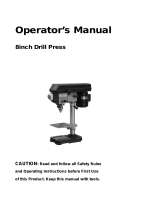
[AWARNINGI
For your own safety, do not try to use your drill press or
plug it in until it is completely assembled and installed
according to the instructions, and until you have read
and understood this instruction manual:
1. YOUR DRILL PRESS MUST BE BOLTED securely
to a workbench. In addition, if there is any tendency
for your drill press to move during certain operations,
bolt the workbench yo the floor.
2. THiS DRILL PRESS is intended for use in dry
conditions, indoor use only.
3. WEAR EYE PROTECTION. USE A face or dust
mask along with safety goggles if drilling operation
is dusty. USE ear protectors, especially during
extended periods of operation.
4. DO NOT wear gloves, neckties, or loose clothing.
5. DO NOT try to dril! material too small to be securely
held.
6. ALWAYS keep hands out of the path of a drill bit.
Avoid awkward hand positions where a sudden slip
could cause your hand to move intothe dril! biL
7. DO NOT install or use any dril! bit that exceeds 175
mm (7 in.) in length or extends 150 mm (6 in.) below
the chuck jaws. They can suddenly bend outward or
break.
8. DO NOT USE wire wheels, router bits, shaper
cutters, circle (fly) cutters, or rotary planers on this
dril! press.
9. WHEN cutting a large piece of materia! ,make sure it
is fully supported at the table height.
10DO NOT perform any operation freehand. ALWAYS
hold the workpiece firmly against the table so it will
not rock or twisL Use clamps or a vise for unstable
workpieces.
11.MAKE SURE there are no nails or foreign objects in
the part of the workpiece to be drilled.
12.CLAMP THE WORKPIECE OR BRACE tT against
the left side of the column to prevent rotation. If it is
too short or the table is tilted, clamp itsolidly to the
table and use the fence provide&
13JF THE WORKPIECE overhangs the table such that
it will fall or tip if not held, clamp it to the table or
provide auxiliary support.
14SECURE THE WORK. Use clamps or a vise to hold
the work when practical, it's safer than using your
hand and it frees both hands to operate tool
1&WHEN using a dril! press vise, always fasten to the
table.
16MAKE SURE all clamps and locks are firmly
tightened before drilling.
17SECURELY LOCK THE HEAD and table support to
the column, and the table to the table support before
operating the drill press.
1&NEVER turn your dril! press on before clearing the
table of all objects (tools, scraps of wood, etc.)
19BEFORE STARTING the operation, jog the motor
switch to make sure the dril! bit does not wobble or
vibrate.
20lET THE SPINDLE REACH FULL SPEED before
starting to drill, if your drill press makes an unfamiliar
noise or if it vibrates excessively, stop immediately,
turn the drill press off and unplug. If do not restart the
unit until the problem is correcte&
21 DO NOT perform layout assembly or set up work on
the table while the drill press is in operation.
22.USE THE RECOMMENDED SPEED for any drill
press accessory and for different workpiece material.
READ THE INSTRUCTIONS that come with the
accessory.
23.WHEN DRiLLiNG large diameter holes, clamp the
workpiece firmly to the table. Otherwise, the bit may
grap and spin the workpiece at high speeds. DO
NOT USE fly cutters or multiple-part hole cutters, as
they can come apart or become unbalanced in use.
24MAKE SURE the spindle has come to a complete
stop before touching the workpiece.
2&TO AVOID INJURY from accidental starting, always
turn the switch "OFF" and unplug the dri!! press
before installing or removing any accessory or
attachment or making any adjustmenL
26KEEP GUARDS tN PLACE and in working order.
27.USE ONLY THE SELF-EJECTING TYPE CHUCK
KEY as provided with the dril! press.




















